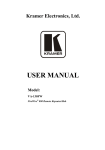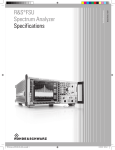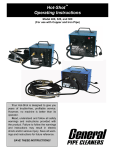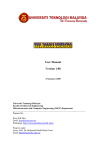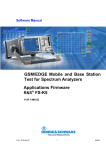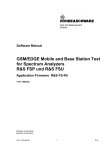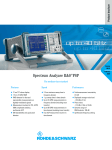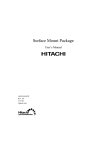Download Product datasheet
Transcript
Spectrum Analyzer R&S FSU The new high-end spectrum analyzer with unmatched performance Features Speed Unmatched performance Versatile resolution filters ◆ Gaussian, FFT, channel, RRC Comprehensive test routines ◆ TOI, OBW, CCDF ◆ Channel power, ACPR ◆ ACPR in time domain Full choice of detectors ◆ Auto Peak, Max Peak, Min Peak, Sample, RMS, Average, Quasi Peak ◆ Fast ACP test routine in time domain ◆ User-configurable list for fast measurements at frequencies of interest ◆ Up to 60 measurements/s in time domain via IEC/IEEE bus (including trace data transfer) Unmatched dynamic range ◆ TOI typ. +25 dBm ◆ 1 dB compression +13 dBm ◆ Phase noise typ. –123 dBc/Hz at 10 kHz offset typ. –160 dBc/Hz at 10 MHz offset ◆ Excellent display linearity <0.1 dB ◆ 84 dB ACLR/3GPP with noise correction Optional electronic attenuator GSM/EDGE Code domain power for 3GPP Milestones The name Rohde&Schwarz has been synonymous with innovative spectrum analyzers since 1986, the unique features of which have repeatedly set standards in this technology. Examples are the analyzers of the R&S FSE and R&S FSIQ families. The Spectrum Analyzer R&S FSU is another milestone. New circuit concepts, advanced RF components, A/D converters and ASIC technology, extensive experience gained from a variety of applications and customer requirements – all this combines to form a solid basis on which the R&S FSU was developed. Its unparalleled features enable the use of new test methods – to your advantage. The future-oriented concept combines unprecedented performance with continuity. The R&S FSU is compatible with the R&S FSE and R&S FSIQ, the industry standards to date. Test routines and sequences generated for the R&S FSE or R&S FSIQ can be used on the R&S FSU too. The R&S FSU family thus secures your investment. The operating concept of the top analyzer R&S FSU is the same as that of the general-purpose analyzer R&S FSP, so these instruments offer a uniform platform for a variety of applications. The R&S FSU family R&S FSU3 20 Hz to 3.6 GHz R&S FSU8 20 Hz to 8 GHz R&S FSU26 20 Hz to 26 GHz 2 Spectrum Analyzer R&S FSU Rohde&Schwarz innovation in spectrum analyzers 1986 1995 1996 1997 1998 R&S FSA – first colour display, first spectrum analyzer to feature –154 dBm (6 Hz) displayed average noise level without the use of preamplifiers, quasi-continuously variable resolution bandwidths, phase noise optimization R&S FSE – fastest analyzer R&S FSE – first spectrum analyzer with RMS detector R&S FSE-B7 – universal vector signal analysis and spectrum analyzer capability combined for the first time R&S FSIQ – first analyzer offering 75 dB dynamic range for UMTS/WCDMA ACLR measurements 1999 2000 2001 R&S FSP – 0.5 dB total measurement uncertainty as standard, fast ACP test routines in time domain, digital channel filters, CCDF R&S FSP-B25 – first electronic attenuator for wear-free use in production R&S FSU – 0.3 dB total measurement uncertainty, 50 MHz resolution bandwidth, +25 dBm TOI Performance surpassing all expectations R&S FSU – ideal for signals requiring wide dynamic range The R&S FSU even surpasses the proven excellent RF data of the R&S FSE and R&S FSIQ families. Measurements calling for an extremely wide dynamic range become even simpler, faster and more reliable – in development, quality management and production. The R&S FSU can rightly be called the new reference in spectrum analysis, with an unprecedented dynamic range: ◆ TOI >20 dBm, typ. +25 dBm ◆ 1 dB compression (0 dB RF attenuation): +13 dBm ◆ Displayed average noise level: –158 dBm (1 Hz bandwidth) ◆ 77 dB ACLR typ. for 3GPP, 84 dB typ. with noise correction ◆ HSOI 55 dBm typ. ◆ Phase noise: –160 dBc/Hz typ. at 10 MHz carrier offset These characteristics make it easy to find small spurious signals even in the presence of strong carriers (e.g. at a base station). For 3GPP adjacent-channel power measurements, a figure of 84 dB ACLR allows good adjacent-channel power ratios to be verified and demonstrated very simply and with high accuracy. Build your node B better than others, and prove it. The high harmonic second-order intercept point means optimum dynamic range for multichannel cable TV measurements. Wealth of functions The R&S FSU is launched with the most abundant functionality available on the spectrum analyzer market. All major functions come straight away in the basic unit: Highly selective digital filters from 10 Hz to 100 kHz Fast FFT filters from 1 Hz to 30 kHz Channel filters from 100 Hz to 5 MHz RRC filters 1 Hz to 50 MHz resolution bandwidth QP detector and EMI bandwidths 200 Hz, 9 kHz, 120 kHz 2.5 ms sweep time in frequency domain 1 µs sweep time in time domain Number of measurement points/trace selectable between 155 and 10001 Time-selective spectrum analysis with gating function GPIB interface, IEEE 488.2 RS-232-C serial interface, 9-pin SUB-D connector VGA output, 15-pin SUB-D PC-compatible screenshots on diskette or hard disk Up to 20 measurements/s in manual mode Up to 30 measurements/s on GPIB interface SCPI-compatible GPIB command set R&S FSE/R&S FSIQ-compatible GPIB command set Fast ACP measurement in time domain Statistical signal analysis with CCDF function RMS detector of 100 dB dynamic range Transducer factor for correcting antenna or cable frequency responses 2-year calibration cycle 3-year warranty1) External reference from 1 MHz to 20 MHz in 1 Hz steps GSM/EDGE modulation measurements (with option R&S FS-K5) 1) Except parts subject to wear and tear (e.g. attenuators) Ready today for tomorrow Functions like ◆ CCDF analysis ◆ Fast ACP measurement in time domain ◆ RMS detector ◆ Selection of filter characteristic ◆ Recording and readout of up to 2 x 512 ksamples of IQ data (8 MHz RF bandwidth) ◆ High measurement accuracy ◆ Excellent display linearity and features like 50 MHz bandwidth mean that the R&S FSU is ready now for tomorrow’s needs. Spectrum Analyzer R&S FSU 3 Shorter development cycles through versatile functions … The most versatile resolution filter characteristics and largest bandwidth found in a spectrum analyzer: To handle the wide variety of measurement tasks in product development, an instrument must offer ample functionality and excellent performance in all areas of interest. The R&S FSU fully meets these requirements. ◆ Standard resolution filters from 10 Hz to 50 MHz in steps of 1, 2, 3, 5 ◆ FFT filters from 1 Hz to 30 kHz ◆ 32 channel filters with bandwidth from 100 Hz to 5 MHz ◆ RRC filters for NADC and TETRA ◆ EMI filters: 200 Hz, 9 kHz, 120 kHz Full choice of detectors for adaptation to a wide range of signal types (Fig. 1): ◆ ◆ ◆ ◆ ◆ ◆ ◆ RMS Auto Peak Max Peak Min Peak Sample Average Quasi Peak 1 Full range of analysis functions: ◆ Time-domain power in conjunction with channel or RRC filters makes the R&S FSU a fully-fledged channel power meter (Fig. 2) ◆ TOI marker (Fig. 3) ◆ Noise/phase-noise marker ◆ Versatile channel/adjacent-channel power measurement functions with wide selection of standards, user-configurable (Fig. 4) ◆ Split-screen mode with selectable settings ◆ CCDF measurement function (Fig. 5) ◆ Peak list marker for fast search of all peaks within the set frequency range (search for spurious) 2 3 4 5 4 Spectrum Analyzer R&S FSU …wide dynamic range and future-proof performance Whether in synthesizer development or front-end design, additional applications add to the R&S FSU functionality while user-friendliness is maintained: Phase noise measurement with Software R&S FS-K4 Phase Noise Measurement Software R&S FS-K4 automates measurement over a complete offset frequency range and determines residual FM from the phase noise characteristic. This in conjunction with the R&S FSU’s extremely low phase noise generally does away with the need for an extra phase noise measurement system, which can be difficult to operate anyway. Noise Measurement Software R&S FS-K3 is a convenient way to determine the noise figure of amplifiers and frequency-converting UUTs throughout the R&S FSU’s frequency range, so enabling complete documentation. The high linearity and extremely accurate power measurement routines of the R&S FSU deliver precise and reproducible results. So why bother with a noise figure meter. phase noise dBc/(1 Hz) -70 -80 -90 -100 -110 -120 -130 -140 -150 -160 -170 SSB phase noise of R&S FSU specification typical 0.1 1 10 100 1000 carrier offset /kHz 10000 Noise figure measurement with Software R&S FS-K3 Fast and simple analysis of anomalies: the cause – spurious or RFI – can easily be traced with the basic analyzer function without additional measuring equipment Spectrum Analyzer R&S FSU 5 From GSM to UMTS… From GSM to UMTS – ready for 3G mobile radio Ref % In conjunction with GSM/EDGE Application Firmware R&S FS-K5, the R&S FSU offers complete functionality for RF and modulation measurements in GSM systems. EDGE, which is the generation 2.5, is already included inthe R&S FS-K5 option. ◆ Phase/frequency error for GSM ◆ Modulation accuracy for EDGE with: – EVM and ETSI-conformant weighting filters – OOS – 95:th percentile – Power versus time with synchronization to midamble – Spectrum due to modulation – Spectrum due to transients The above features plus wide dynamic range make the R&S FSU an ideal tool in base station development and testing. This is enhanced by excellent characteristics ready incorporated in the standard unit, e.g. <0.3 dB total measurement uncertainty, gated sweep and IF power trigger. 3 dBm Att 20 dB Marker 1 [T1] 0.110 % 504.176400 µs SWT 524.25 µs 40 SUMMARY [T1] PEAK HLD 1.157 PEAK AVG 0.642 RMS HLD 0.362 RMS AVG 0.262 FREQ HLD 164.55 FREQ AVG 163.53 OOS HLD 39.70 OOS AVG 43.59 PERC HLD 0.630 PERC AVG 0.510 36 1 SA CLRWR 2 PK MAXH 3 MI MINH 32 28 24 % % % % Hz Hz dB dB % % TRG PRN 20 16 12 8 4 1 0 Center 890.2 MHz 52.43 µs/ Measurement of modulation accuracy on EDGE burst Power versus Time Ref * Att 0 dBm 5 dB SWT 4.837 ms POWER [T1] 10 LIMIT CHECK PVTU_E8A POS 0 dBm 0 1 1 RM AVG 2 PK MAXH 3 MI MINH Marker 1 [T1 ] -4.21 dBm 409.965607 µs PASS PVTU_E8B -10 -20 -30 PRN Even in its basic version, the R&S FSU offers the functionality and characteristics needed to develop, verify and produce 3G mobile radio systems: ◆ RMS detector, provided as standard in Rohde&Schwarz analyzers for many years and allowing accurate power measurements independently of signal form; 3GPP specifications stipulate RMS power measurements for most tests 6 Spectrum Analyzer R&S FSU EXT -40 SWP 100 of 100 -50 -60 SWP 100 of 100 -70 -80 PVTL_E8A T1 T2 PVTL_E8B -90 Center 1 GHz Measurement of power ramp on EDGE burst 483.7 µs/ …ready for 3G mobile radio ◆ ACP measurement function for 3GPP with 3.84 MHz bandwidth RRC filter for standard-conformant adjacentchannel power measurements with a dynamic range limit of 77.5 dB ◆ Dedicated CCDF measurement function that determines the probability of instantaneous signal power exceeding average power. CCDF measurement is indispensable to determine optimum transmit power for CDMA signals, assuming that clipping at known, short intervals is tolerable. dBc -50 -55 ACLR -60 -65 total ACLR -70 -75 -85 phase noise -90 Standard 3GPP modulation and code domain power measurements spectrum regrowth thermal noise -80 -20 -15 -10 -5 mixer level 0 dBm Dynamic range of R&S FSU for adjacent-channel power measurement on WCDMA signal without noise correction ◆ For BTS/node B signals: Application Firmware R&S FS-K72 ◆ For UE signals: Application Firmware R&S FS-K73 ◆ High measurement speed of 4 s/measurement ◆ Code domain power and CPICH power ◆ EVM and PCDE ◆ Code domain power vs. slot ◆ EVM/code channel ◆ Spectrum emission mask WCDMA code domain power measurement with R&S FSU and R&S FS-K72 Spectrum Analyzer R&S FSU 7 What can we do … Short test cycles, high throughput Downtime and repair time cut to a minimum Another step enhancing the reliability of your test system! The R&S FSU is just the right instrument for this. Fast data transfer on the IEC/IEEE bus or an Ethernet LAN plus intelligent routines optimized for speed make for very short measurement times: Limited lifetime of mechanical attenuators due to high throughput The R&S FSU-B25 option solves this problem. The electronic attenuator with 25 dB setting range does away with any mechanical switching – so the R&S FSU’s high accuracy is maintained without any early failure. A two-year calibration cycle minimizes downtime for instrument calibration. Existing programs for R&S FSE, R&S FSIQ or R&S FSP can be used on R&S FSU The R&S FSU complies with SCPI conventions and is IEC/IEEE-bus-compatible with respect to the R&S FSE and R&S FSIQ. These instruments can in most cases be directly replaced with no or only minor changes to the software. If changes have to be made, they affect only those program parts that concern the speedoptimized measurement routines of the R&S FSU. ◆ FAST ACP: for the major mobile radio standards with high reproducibility and accuracy ◆ List mode: combined measurement of various parameters at a single command ◆ Fast time domain power measurement using channel or RRC filters ◆ Up to 60 measurements/s in zero span via IEC/IEEE bus including trace data transfer ◆ Fast-sweeping FFT filters for spurious measurement at low levels ◆ Fast frequency counter: 0.1 Hz resolution for a measurement time of <30 ms Spurious emission measurements without notch filter The R&S FSU is an ideal choice for this type of measurement, even for tests on GSM base stations. The extremely low phase noise and high 1 dB compression point of the R&S FSU enable direct measurements without the use of extra automatic or manually tuned notch filters. This eliminates possible sources of error and makes measurements simpler and more reliable. External frequency standards The R&S FSU accepts signals between 1 MHz and 20 MHz in steps of 1 Hz. Probability density Yield for 1 dB total measurement uncertainty Additional yield for 0.3 dB total measurement uncertainty -1.5 -1 -0.3 Deviation from mean power [dB] +0.3 1 2 3 Tole ran ce lim it 4 5 Tes 6 tm arg in 7 8 9 10 11 12 13 Production sample Effect of measurement uncertainty on production yield 8 Spectrum Analyzer R&S FSU …to boost your production yield? Higher production yield Enhanced measurement accuracy makes for higher production yield. The safety margins that usually compensate for the measurement uncertainty of test systems can be reduced, so increasing the accept (passed) region. Given the same spread of results, more products will pass the test. The R&S FSU helps you boost your production yield featuring a total measurement uncertainty of <0.3 dB (2σ). ASCII format Binary IEEE754 format Sweeps/s span 10 MHz, sweep time 2.5 ms 30 50 Sweeps/s span 0 Hz, sweep time 100 µs 40 60 Measurement speed on GPIB interface Settings: display off, default coupling, single trace, 625 points Ref 6 dBm Att 20 dB SWT 100 ms 0 With 30 measurements/s in manual mode, minimum sweep time of 2.5 ms and 1 µs zero span as standard, the R&S FSU is ideal for time-critical applications. The highly selective, fast-sweeping digital filters featuring "analog response" allow measurements on pulsed signals as well as use of the built-in frequency counter. -10 A SGL -20 1 RM * -30 CLRWR -40 -50 -60 -70 -80 PRN -90 Center 2.1175 GHz Tx Channel Power EXT 10 ms/ -0.01 dBm Bandwidth 3.84 MHz Adjacent Channel Lower Upper -56.49 dBc -56.45 dBc Bandwidth Spacing 3.84 MHz 5 MHz Alternate Channel Lower Upper -57.10 dBc -57.02 dBc Bandwidth Spacing 3.84 MHz 10 MHz Measurement of adjacent-channel power versus time: FAST ACP Input command SENSE:LIST:POW 100MHz,-0dBm,10dB,10dB,NORM,1MHz,3MHz,434us,0, 200MHz,-20dBm,10dB,0dB,NORM,30kHz,100kHz,1ms,0, 300MHz,-20dBm,10dB,0dB,NORM,30kHz,100kHz,1ms,0; Output FSU -28.3, -30.6, -38.1 Remote control of R&S FSU via IEC/IEEE bus in list mode cuts down on measurement times Spectrum Analyzer R&S FSU 9 Profit from the advantages of networking Versatile documentation and networking capabilities The standard disk drive makes it easy for you to integrate results into documentation – simply save the screen contents as a BMP or WMF file and import them into your word processing system. To process trace data, save them as an ASCII file (CSV format), which not only documents trace data but also the main instrument settings. Make use of the advantages offered by networking The option R&S FSU-B16 opens up versatile networking capabilities: ◆ Link to standard network (Ethernet 10/100BaseT) ◆ Running under Windows NT, the R&S FSU can be configured for network operation. Applications like data output to a central network printer or saving results on a central server can easily be implemented. The R&S FSU can thus be optimally matched to a given work environment. ◆ You can import screen contents straight into your documentation programs by Word for Windows or an MS Excel macro and so immediately create data sheets for your products or documents for quality assurance. Remote control by Ethernet is even simpler: ◆ PCAnywhere software: PCAnywhere allows mouse operation of the R&S FSU after assigning it a TCP/IP address. All elements of the R&S FSU screen are represented by a soft front panel function; the complete R&S FSU screen shows on the remote PC. Server Printer FSU remotely controlled PC with PCAnywhere R&S FSU R&S FSU in networked operation R&S FSU remotely controlled with PCAnywhere 10 Spectrum Analyzer R&S FSU ◆ Special RSIB interface This links your application to the TCP/IP protocol and acts like an IEC/IEEE-bus driver. The RSIB interface is available for Windows and the UNIX world. The R&S FSU can be programmed via this interface just like on the familiar IEC/IEEE bus. Specifications Specifications apply under the following conditions: 30 minutes warm-up time at ambient temperature, specified environmental conditions met, calibration cycle adhered to, and total calibration performed. Data without tolerances: typical values only. Data designated “nominal“ apply to design parameters and are not tested. Data designated “σ = xx dB“ are shown as standard deviation . R&S FSU3 R&S FSU8 R&S FSU26 Frequency Frequency range 20 Hz to 3.6 GHz 20 Hz to 8 GHz 20 Hz to 26.5 GHz DC coupled 1 MHz to 3.6 GHz 1 MHz to 8 GHz 10 MHz to 26.5 GHz AC coupled Frequency resolution 0.01 Hz Internal reference frequency (nominal) with standard OCXO Aging per day 1) 1 x 10–9 Aging per year 1) 1 x 10–7 Temperature drift 8 x 10–8 (0°C to +50°C) Total error (per year) 1) 1.8 x 10–7 Internal reference frequency (nominal); option R&S FS-B4 Aging per day 1) 2 x 10–10 Aging per year 1) 3 x 10–8 Temperature drift 1 x10–9 (0°C to +50°C) Total error (per year) 1) 5 x 10–8 External reference 1 MHz to 20 MHz, 1 Hz steps frequency Frequency display with marker or frequency counter Marker resolution 0.1 Hz to 10 kHz (dependent on span) Max. deviation ±(marker frequency x reference error + 0.5 % x span (sweep time >3 x +10 % x resolution bandwidth + ½ (last digit)) auto sweep time) Frequency counter 0.1 Hz to 10 kHz (selectable) resolution Count accuracy ±(frequency x reference error + ½ (last digit)) (S/N >25 dB) Frequency span 0 Hz, 0 Hz, 0 Hz, 10 Hz to 3.6 GHz 10 Hz to 8 GHz 10 Hz to 26.5 GHz Span resolution/ 0.1 Hz/1 % max. span deviation Spectral purity (dBc(1Hz)), SSB phase noise, f = 640 MHz Residual FM <1 Hz nominal Carrier offset typ. –73 dBc(1Hz), with option R&S FS-B4 typ. –86 dBc 10 Hz 100 Hz <–90 dBc(1Hz), typ. –100 dBc(1Hz) 1 kHz <–112 dBc(1Hz), typ. –116 dBc(1Hz) 10 kHz <–120 dBc(1Hz), typ. –123 dBc(1Hz) 100 kHz <–120 dBc(1Hz), typ. –123 dBc(1Hz) 1 MHz <–138 dBc(1Hz), typ. –144 dBc(1Hz) 10 MHz <–155 dBc(1Hz) nominal, typ. –160 dBc(1Hz) Sweep Span 0 Hz 1 µs to 16000 s in steps of 5% Span ≥10 Hz 2.5 ms to 16000 s in steps ≤10% Max. deviation of 3% sweep time Sampling rate 31.25 ns (32 MHz A/D converter) Measurement in with marker and display lines (resolution 31.25 ns) time domain R&S FSU3 R&S FSU8 R&S FSU26 Resolution bandwidths Analog filters 3 dB bandwidths 10 Hz to 20 MHz in 1/2/3/5 sequence, 50 MHz Bandwidth error 10 Hz to 100 kHz <3% 200 kHz to 5 MHz <10% 10 MHz, 20 MHz –30% to + 10% 50 MHz –30% to +10% –30% to +10% for f<3.6 GHz –30% to +100% for f>3.6 GHz Shape factor –60 dB: –3 dB ≤100 kHz <6 200 kHz to 2 MHz <12 3 MHz to 10 MHz <7 20 MHz, 50 MHz <6 nominal Video bandwidths 1 Hz to 10 MHz in 1/2/3/5 sequence FFT filters 3 dB bandwidths 1 Hz to 30 kHz in 1/2/3/5 sequence Bandwidth error <5% nominal Shape factor <3 nominal –60 dB: –3 dB EMI filters 6 dB bandwidths 200 Hz, 9 kHz, 120 kHz Bandwidth error <3% nominal Shape factor <6 nominal –60 dB : –3 dB Channel filters Bandwidths 100, 200, 300, 500 Hz, 1, 1.5, 2, 2.4, 2.7, 3, 3.4, 4, 4.5, 5, 6, 8.5, 9, 10, 12.5, 14, 15, 16, 18 (RRC), 20, 21, 24.3 (RRC), 25, 30, 50, 100, 150, 192, 200, 300, 500 kHz, 1, 1.228, 1.5, 2, 3, 5 MHz Shape factor <2 nominal –60 dB : –3 dB Bandwidth error 2% nominal Level Display range displayed average noise level to 30 dBm Maximum input level DC voltage 50 V (AC coupling) DC voltage 0V (DC coupling) RF attenuation 0 dB CW RF power 20 dBm (= 0.1 W) Pulse spectral density 97 dBµV/1 MHz RF attenuation ≥10 dB CW RF power 30 dBm (= 1 W) Max. pulse voltage 150 V Max. pulse energy 1 mWs (10 µs) 1 dB compression +13 dBm nominal +13 dBm nominal up to 3.6 GHz – +10 dBm nominal +7 dBm nominal of input mixer from 3.6 GHz from 3.6 GHz (0 dB RF attenuato 8 GHz to 26 GHz tion) Intermodulation Third-order intermodulation Third-order inter>17 dBm, >17 dBm, >17 dBm, cept (TOI), level 2 x typ. 20 dBm typ. 20 dBm typ. 20 dBm –10 dBm, for f = 10 MHz to for f = 10 MHz to for f = 10 MHz to ∆f >5 x RBW or 300 MHz 300 MHz 300 MHz 10 kHz, whichever is >+20 dBm, >+20 dBm, >+22 dBm, the greater value typ.+25 dBm typ.+25 dBm typ.+27 dBm for f >300 MHz for f = 300 MHz for f = 300 MHz to 3.6 GHz to 3.6 GHz >+18 dBm, >+12 dBm, typ.+23 dBm typ. +15 dBm for f = 3.6 GHz for f = 3.6 GHz to 8 GHz to 26.5 GHz 1) After 30 days of continuous operation. Spectrum Analyzer R&S FSU 11 R&S FSU3 R&S FSU8 R&S FSU26 Second harmonic intercept point (SHI) fin ≤100 MHz >35 dBm 100 MHz<fin >45 dBm, typ. 55 dBm ≤400 MHz 400 MHz< fin ≤500 Hz >52 dBm, typ. 60 dBm 500 MHz< fin ≤1 GHz >45 dBm, typ. 55 dBm 1 GHz < fin ≤ 1.8 GHz >35 dBm fin > 1.8 GHz – >80 dBm nominal Displayed average noise level (0 dB RF attenuation, RBW 10 Hz, VBW 30 Hz, 20 averages, trace average, span 0 Hz, termination 50 Ω) Frequency <–80 dBm 20 Hz 100 Hz <–100 dBm 1 kHz <–110 dBm 10 kHz <–120 dBm 100 kHz <–120 dBm 1 MHz <–130 dBm 10 MHz to 2 GHz <–145 dBm, typ. –148 dBm <–142 dBm, typ. –146 dBm 2 GHz to 3.6 GHz <–143 dBm, <–143 dBm, <–140 dBm, typ. –147 dBm typ. –145 dBm typ. –143 dBm 3.6 GHz to 7 GHz <–142 dBm, <–142 dBm, – typ. –146 dBm typ. –144 dBm 7 GHz to 8 GHz – <–140 dBm – 3.6 GHz to 8 GHz – – <–142 dBm, typ. –146 dBm 8 GHz to 13 GHz – – <–140 dBm, typ. –143 dBm 13 GHz to 18 GHz – – <–138 dBm, typ. –141 dBm 18 GHz to 22 GHz – – <–137 dBm, typ. –140 dBm 22 GHz to 26.5 GHz – – <–135 dBm, typ. –138 dBm Maximum dynamic range 1 dB compression to 170 dB DANL (1 Hz) Immunity to interference Image frequency f ≤ 3.6 GHz >90 dB, typ. >110 dB f >3.6 GHz – >70 dB, typ. 100 dB Intermediate frequency f ≤ 3.6 GHz >90 dB, typ. >110 dB 3.6 GHz ≤f ≤4.2 GHz – typ. 70 dB f > 4.2 GHz >70 dB, typ. >90 dB Spurious responses <–103 dBm (f > 1 MHz, without input signal, 0 dB attenuation) Other spurious (∆f>100 kHz) fin < 2.3 GHz <–80 dBc (mixer level ≤ –10 dBm) 2.3 GHz≤ fin<4 GHz <–70 dBc (mixer level ≤ –35 dBm) 4 GHz≤fin < 26.5 GHz <–80 dBc (mixer level ≤ –10 dBm) Level display (spectrum mode) Screen 625 x 500 pixels (one diagram), max. 2 diagrams with independent settings Logarithmic level 1 dB, 10 dB to 200 dB in steps of 10 dB axis Linear level axis 10% of reference level per level division, 10 divisions or logarithmic scaling Traces max. 6, with two diagrams on screen max. 3 per diagram Trace detector Max Peak, Min Peak, Auto Peak (normal), Sample, RMS, Average, Quasi Peak Trace functions Clear/Write, Max Hold, Min Hold, Average Number of measure625, settable between 155 and 100001 ment points in steps of about the factor 2 R&S FSU3 R&S FSU8 R&S FSU26 Setting range of reference level Logarithmic level –130 dBm to (+5 dBm + RF attenuation), max. 30 dBm, display in steps of 0.1 dB Linear level display 7.0 nV to 7.07 V in steps of 1% Units of level axis dBm, dBµV, dBmV, dBµA, dBpW (log level display) / µV, mV, µA, mA, pW, nW (linear level display) Level measurement error Reference error at <0.2 (σ = 0.07) dB 128 MHz, RBW ≤100 kHz, reference level –30 dBm, RF attenuation 10 dB Frequency response (DC coupling, RF attenuation ≥ 10 dB) 10 MHz to 3.6 GHz <0.3 dB (σ = 0.1 dB)1) 3.6 GHz to 8 GHz – <1.5 dB (σ = 0.5 dB)2) 8 GHz to 22 GHz – – <2 dB (σ = 0.7 dB)2) 22 GHz to 26.5 GHz – – <2.5 dB (σ = 0.8 dB)2) Attenuator (≥5 dB) <0.2 dB (σ = 0.07 dB) Reference level <0.15 dB (σ = 0.05 dB) switching Display nonlinearity (20 °C to 30 °C, mixer level ≤–10 dBm) Logarithmic level display RBW ≤100 kHz, S/N >20 dB 0 dB to –70 dB <0.1 dB (σ = 0.03 dB) –70 dB to –90 dB <0.3 dB (σ = 0.1 dB) 10 MHz ≥ RBW ≥ 200 kHz, S/N >16 dB 0 dB to –50 dB <0.2 dB (σ = 0.07 dB) –50 dB to –70 dB <0.5 dB (σ=0.17 dB) RBW ≥ 10 MHz 0 dB to –50 dB <0.5 dB (σ = 0.17 dB) Linear level display 5 % of reference level Bandwidth switching error (ref. to RBW = 10 kHz) 10 Hz to 100 kHz – 200 kHz to 10 MHz <0.2 dB (σ = 0.07 dB) 5 MHz to 50 MHz <0.5 dB (σ = 0.15 dB) FFT 1 Hz to 3 kHz <0.2 dB (σ = 0.07 dB) Total measurement error (0 dB to –70 dB, S/N >20 dB, span/RBW <100, 95 % confidence level) (20 °C to 30 °C, mixer level ≤–10 dBm) <3.6 GHz 0.3 dB for RBW ≤ 100 kHz 0.5 dB for RBW > 100 kHz 3.6 GHz to 8 GHz – <2.0 dB 8 GHz to 18 GHz – – <2.5 dB 18 GHz to 26.5 GHz – – <3.0 dB Audio demodulation Modulation modes Audio output Marker hold time in spectrum mode AM and FM loudspeaker and headphones output 100 ms to 60 s Trigger functions Trigger Span ≥10 Hz Trigger source Trigger offset Span = 0 Hz Trigger source Trigger offset Max. deviation of trigger offset Gated sweep Trigger source Gate delay Gate length Max. deviation of gate length free run, video, external, IF level (mixer level >–20 dBm) 125 ns to 100 s, resolution 125 ns min. (or 1 % of offset) free run, video, external, IF level (mixer level >–20 dBm) ± 125 ns to 100 s, resolution 125 ns min., dependent on sweep time ± (125 ns + (0.1 % x delay time)) external, IF level, video 1 µs to 100 s 125 ns to 100 s, resolution min. 125 ns or 1 % of gate length ±(125 ns + (0.05 % x gate length)) Spectrum Analyzer R&S FSU 12 R&S FSU3 R&S FSU8 R&S FSU26 Inputs and outputs (front panel) RF input N female, 50 Ω VSWR; RF attenuation ≥10 dB, DC coupling f <3.6 GHz <1.5 f <8 GHz – <2.0 <1.8 f <18 GHz – – <1.8 f <26.5 GHz – – <2.0 RF attenuation typ. 1.5 <10 dB or AC coupling Setting range of 0 dB to 75 dB in 5 dB steps attenuator Probe power supply +15 V DC, –12.6 V DC and ground, max. 150 mA nominal Power supply for 5-pin connector antennas Supply voltages ±10 V and ground, max. 100 mA nominal Keyboard Keyboard connector PS/2 female for MF2 keyboard AF output AF output 3.5 mm mini jack Output impedance 10 Ω Open-circuit voltage up to 1.5 V, adjustable Inputs and outputs (rear panel) IF 20.4 MHz Bandwidth RBW ≤ 100 kHz 10 MHz ≥ RBW ≥ 200 kHz Level RBW ≤ 100 kHz, FFT 10 MHz≥RBW≥ 200 kHz IF 404.4 MHz Zout = 50 Ω, BNC female 1.5 x resolution bandwidth, min. 2.6 kHz same as resolution bandwidth –20 dBm at reference level, mixer level >–70 dBm 0 dBm at reference level, mixer level >–50 dBm Zout = 50 Ω, BNC female 404.4 MHz IF output active only if RBW >10 MHz Bandwidth RBW > 10 MHz same as resolution bandwidth Level Mixer level ≤ 0 dBm mixer level –10 dB typ., only active if RBW 20.50 MHz Video output Zout = 50 Ω, BNC female Voltage 0 V to 1 V, full scale (open-circuit voltage), logarithmic (RBW ≥200 kHz) scaling Reference frequency Output BNC female Output frequency 10 MHz Level >0 dBm nominal Input BNC female Input frequency 1 MHz to 20 MHz in 1 Hz steps range Required level >0 dBm from 50 Ω Sweep output BNC female, 0 V to 5 V, proportional to displayed frequency Power supply conBNC female, 0 V and 28 V, switchable, nector for noise max. 100 mA source External trigger/ BNC female, >10 kΩ gate input Trigger voltage 1.4 V IEC/IEEE-bus interface to IEC 625-2 (IEEE 488.2) remote control Command set SCPI 1997.0 Connector 24-pin Amphenol female Interface functions SH1, AH1, T6, L4, SR1, RL1, PP1, DC1, DT1, C0 Serial interface RS-232-C (COM), 9-pin SUB-D female Printer interface parallel (Centronics-compatible) Mouse connector PS/2 female Connector for exter15-pin SUB-D female nal monitor (VGA) 1) 2) Valid for temperatures between +20°C and +30°C; <0.6 dB for temperatures between +5°C and +45°C. Valid for temperatures between +20°C and +30°C and span <1 GHz; add < 0.5 dB for temperatures between +5°C and +45°C or span >1 GHz. General data Display 21 cm TFT LCD colour display (8.4") Resolution 800 x 600 pixels (SVGA resolution) Pixel failure rate <1 x 10 –5 Mass memory 1.44 Mbyte 3½" disk drive, hard disk Data storage >500 instrument settings and traces Operating temperature range Rated temperature +5 °C to +40 °C range Limit temperature +0 °C to +50 °C range Storage temperature –40 °C to +70 °C range Damp heat +40 °C at 95 % relative humidity (IEC 68–2–3) Mechanical resistance Vibration , sinusoidal 5 Hz to 150 Hz, max. 2 g at 55 Hz; 0.5 g from 55 Hz to 150 Hz; meets IEC 68-2-6, IEC 68-2-3, IEC 1010-1, MIL-T-28800D, class 5 Vibration, random 10 Hz to 100 Hz, acceleration 1 g (rms) Shock test 40 g shock spectrum, meets MIL-STD-810C and MIL-T-28800D, classes 3 and 5 Recommended 2 years for operation with external reference, calibration interval 1 year with internal reference RFI suppression meets EMC directive of EU (89/336/EEC) and German EMC law Power supply AC supply 100 V AC to 240 V AC, 3.1 A to 1.3 A, 50 Hz to 400 Hz, class of protection I to VDE 411 Power consumption typ. 130 VA typ. 150 VA Safety meets EN 61010-1, UL 3111-1, CSA C22.2 No. 1010-1, IEC 1010-1 Test mark VDE, GS, CSA, CSA-NRTL Dimensions 435 mm x 192 mm 435 mm x 192 mm (W x H x D) x 460 mm x 460 mm Weight 14.6 kg 15.4 kg Optional Extended Environmental Specification R&S FSU-B20 Temperature range (without condensation) Rated temperature range 0°C to +50°C Limit temperature range 0°C to +55°C Mechanical resistance Vibration, random 10 Hz to 300 Hz, acceleration 1.9 g (rms) Optional Electronic Attenuator R&S FSU-B25 Frequency Frequency range R&S FSU 3 R&S FSU 8 R&S FSU 26 10 MHz to 3.6 GHz 10 MHz to 8 GHz 10 MHz to 3.6 GHz Setting range Electronic attenuator Preamplifier Maximum level measurement error 0 dB to 30 dB, 5 dB steps 20 dB, switchable Frequency response, with preamplifier or electronic attenuator 10 MHz to 50 MHz <1 dB 50 MHz to 3.6 GHz <0.6 dB 3.6 GHz to 8 GHz <2.0 dB Reference error at 128 MHz, RBW ≤100 kHz, reference level –30 dBm, RF attenuation 10 dB Electronic attenuator <0.3 dB Preamplifier <0.3 dB Spectrum Analyzer R&S FSU 13 With the R&S FSU-B25 built in, the average noise level values displayed by the basic units degrade by (R&S FSU-B25 off): 20 Hz to 3.6 GHz 1 dB 3.6 GHz to 8 GHz 2 dB Preamplifier off, electronic attenuator 0 dB 20 Hz to 3.6 GHz 3.6 GHz to 8 GHz Intermodulation typ. 2.5 dB typ. 3.5 dB Third-order intermodulation, third-order intercept (TOI), electronic attenuator on, ∆f > 5 x RBW or 10 kHz 10 MHz to 300 MHz 300 MHz to 3.6 GHz 3.6 GHz to 8 GHz >17 dBm >20 dBm >18 dBm Ordering information Order designation Type Order No. Spectrum Analyzer 20 Hz to 3.6 GHz R&S FSU3 1129.9003.03 Spectrum Analyzer 20 Hz to 8 GHz R&S FSU8 1129.9003.08 Spectrum Analyzer 20 Hz to 26.5 GHz R&S FSU26 1129.9003.26 Accessories supplied Power cable, operating manual, service manual; R&S FSU26: test port adapter with 3.5 mm female (1021.0512.00) and N female (1021.0535.00) connector Type R&S FSE-Z15 Order No. 1046.2002.02 – R&S PSP-Z2 R&S FSE-Z2 R&S PMC3 R&S PCK R&S PCK R&S ZZA-411 R&S ZZA-T45 0708.9010.00 1091.4100.02 1084.7043.02 1082.6004.04 0292.2013.10 0292.2013.20 1096.3283.00 1109.3774.00 R&S RAM R&S RAZ R&S ZRB2 R&S ZRC 0358.5414.02 0358.5714.02 0373.9017.52 1039.9492.52 R&S RBU 100 1073.8820.XX (XX=03/06/10/20/ 30) High-Power Attenuators, 50 W 3/6/10/20/30 dB R&S RBU 50 20 dB, 6 GHz R&S RDL 50 1073.8895.XX (XX=03/06/10/20/ 30) 1035.1700.52 Options Order designation Options Delete Manual Highly Accurate Reference Frequency External Generator Control LAN Interface100BT Removable Hard Disk Second Hard Disk for FSU-B18 Extended Environmental Specification Electronic Attenuator, 0 dB to 30 dB, with integrated 20 dB preamplifier Software Noise Measurement Software Phase Noise Measurement Software GSM/EDGE Application Firmware FM Measurement Demodulator 3GPP BTS/Node B FDD Application Firmware Service Kit 1) 2) 3) Type Order No. R&S FSU-B0 R&S FSU-B4 R&S FSP-B10 R&S FSU-B16 R&S FSU-B181) 2) R&S FSU-B192) R&S FSU-B203) R&S FSU-B25 1144.9998.02 1144.9000.02 1129.7246.02 1144.9498.02 1145.0242.02 1145.0394.02 1155.1606.04 1144.9298.02 R&S FS-K3 R&S FS-K4 R&S FS-K5 R&S FS-K7 R&S FS-K72 1057.3028.02 1108.0088.02 1141.1496.02 1141.1796.02 1154.7000.02 R&S FSU-Z1 1145.0042.02 Certified Environmental System Certified Quality System ISO 14001 ISO 9001 REG. NO 1954 DQS REG. NO 1954 Factory installation only. Not with R&S FSU-B20. Not with R&S FSU-B18/-B19. ROHDE&SCHWARZ GmbH & Co. KG ⋅ Mühldorfstraße 15 ⋅ D-81671 München ⋅ Germany ⋅ P.O.B. 8014 69 ⋅ D-81614 München ⋅ Germany ⋅ Telephone +49894129-0 www.rohde-schwarz.com ⋅ CustomerSupport: Telephone. +491805124242, Fax +4989 4129-13777, E-mail: [email protected] 0302 (U as) <–152 dBm <–150 dBm <–147 dBm Order designation Microwave Measurement Cable with Adapter Set (for R&S FSU26 only) Headphones US Keyboard with trackball PS/2 Mouse Colour Monitor, 17", 230 V IEC/IEEE-Bus Cable, 1 m IEC/IEEE-Bus Cable, 2 m 19" Rack Adapter Adapter for mounting on telescopic rails (only with 19" Adapter ZZA-411) Matching Pads, 75 Ω L Section Series Resistor, 25 Ω SWR Bridge, 5 MHz to 3000 MHz SWR Bridge, 40 kHz to 4 GHz High-Power Attenuators, 100 W, 3/6/10/20/30 dB Printed in Germany Preamplifier on 10 MHz to 2.0 GHz 2.0 GHz to 3.6 GHz 3.6 GHz to 8.0 GHz Recommended extras PD 757.6504.24 ⋅ Spectrum Analyzer R&S FSU ⋅ Trade names are trademarks of the owners ⋅ Subject to change ⋅ Data without tolerances: typical values Displayed average noise level RBW=1 kHz, VBW=3 kHz, zero span, sweep time 50 ms, 20 averages, mean marker, normalized to 10 Hz RBW















